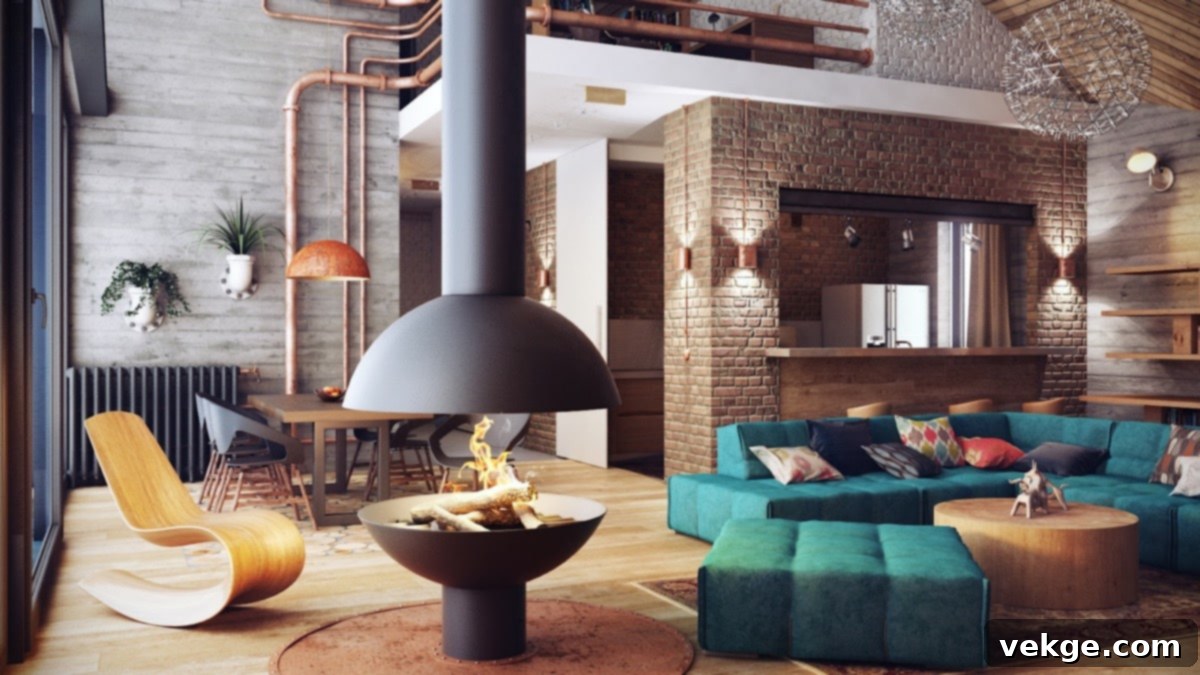Mastering Industrial Home Decor: Your Ultimate Guide to Urban Chic Design
Industrial home decor has captivated design enthusiasts for over four decades, evolving from its factory-inspired origins into a highly sought-after aesthetic. Primarily found in urban dwellings, spacious lofts, and modern apartments, this unique interior design style thrives on adding distinctive character and a touch of rugged individuality to living spaces. But what exactly gives industrial design its enduring appeal and makes it so special? If you’re looking to infuse your home with this blend of raw beauty and sophisticated simplicity, you’ve come to the right place. Keep reading as we delve into the core elements that define this captivating style.
Inspired by the repurposed factories, warehouses, and industrial buildings of the past, industrial interior design seamlessly blends chic minimalism with a raw, authentic feel. The term “industrial” often conjures images of harsh, cold environments, leading many to mistakenly believe the style is stark and uninviting. However, the reality is quite the opposite. Industrial design skillfully embraces a home’s inherent structure, celebrating exposed elements and utilitarian materials while creating an surprisingly cozy and welcoming atmosphere. It’s a design philosophy that values authenticity, functionality, and a narrative of transformation, turning the ordinary into the extraordinary.
If you’re eager to transform your home with the distinctive charm of industrial interiors, we’ve curated an extensive list of essential elements that are perfect for your next house makeover. These carefully selected components will help you achieve a cohesive and authentic industrial theme, allowing you to craft a space that feels both modern and timeless. Let’s explore these fundamental elements that will bring your industrial vision to life.
Essential Elements for Industrial Home Decor
1. Exposed Pipes and Ducts: Celebrating Structural Honesty
One of the most defining and authentic elements of industrial home decor is the intentional exposure of a building’s functional infrastructure. To truly emulate that coveted factory-like aesthetic, you’ll want to showcase pipes, electrical conduits, and air ducts. Rather than concealing these utilitarian features behind walls and ceilings, industrial design proudly brings them into view, celebrating their raw beauty and contributing to the space’s character. This raw exposure provides an immediate sense of authenticity and historical narrative, perfectly aligning with the core motive of industrial interior design – to reveal the bones of the building and embrace its imperfections. Whether they’re painted a striking black or left in their natural metallic state, exposed pipes and ducts become architectural statements, adding an edgy, urban charm that is both functional and decorative.

2. Integrating Accents of Metal and Wood: The Core Duo
Metal and wood are not just elements; they are the fundamental building blocks for crafting a truly authentic industrial look. The strategic use of metal, particularly black or aged metal, introduces a sleek, chic visual and structural integrity to any space. Think sturdy iron frameworks, steel accents, or even repurposed machinery parts. Complementing this, the warmth and texture of wood provide a crucial balance. Furniture crafted from reclaimed or repurposed wood, along with wooden wall panels or accents, adds depth and a gorgeous, rustic touch. The interplay between the cold, hard lines of metal and the organic, natural grain of wood creates a dynamic contrast that is signature to industrial design. Experiment with various pieces that incorporate both materials – from dining tables with metal bases and wooden tops to shelving units combining steel frames with solid timber shelves – to give your home a clean, sophisticated, yet undeniably rugged appearance.
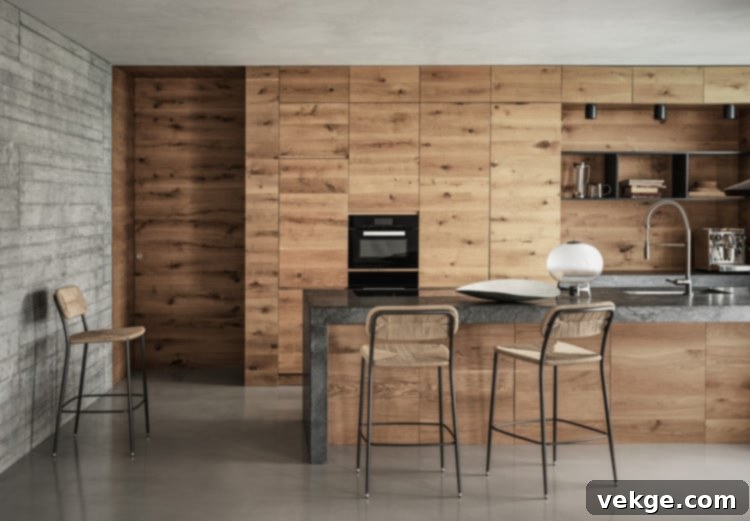
3. The Charm of Exposed Brick Walls: A Rustic Foundation
Exposed brick walls are perhaps the most iconic and instantly recognizable element in industrial interior design, deliberately showcased to evoke the rich history of the industrial era. These walls impart an immediate sense of character and provide a grounding, rustic feel to any home. They tell a story of longevity and raw beauty, often acting as a striking focal point in a room. While having genuine exposed brick is ideal, it might not always be feasible in modern constructions or existing homes. Fortunately, there are excellent alternatives, such as faux brick panels or even high-quality brick-patterned wallpapers, that can convincingly replicate the look and impression of an unfinished factory or a historic building. When paired with metal and wood, exposed brick creates a warm yet edgy backdrop that perfectly encapsulates the industrial spirit.
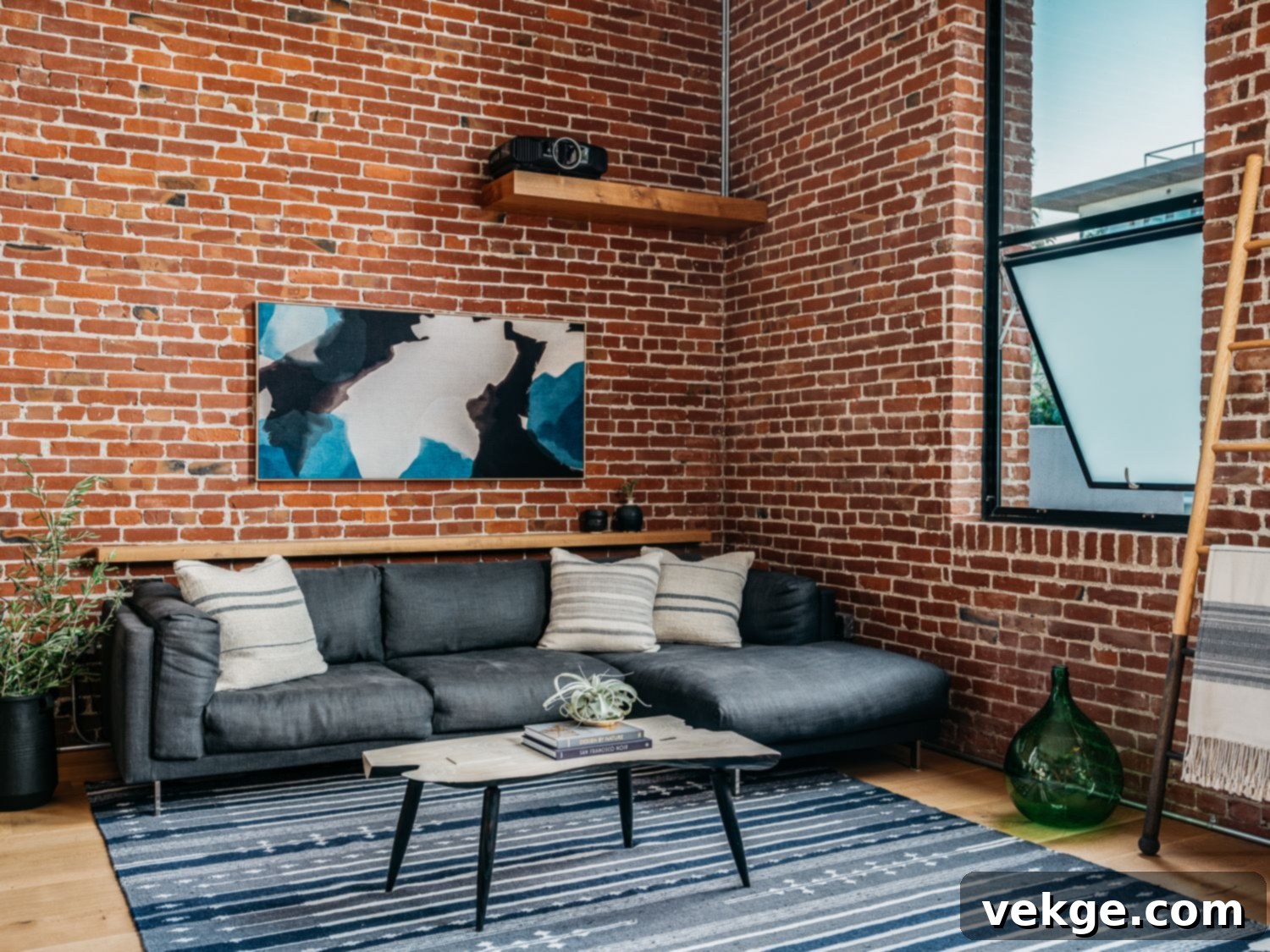
4. Vintage and Antique Pieces: Weaving in History and Character
To truly elevate the industrial interior design of your home, incorporate carefully chosen vintage and antique pieces into your furniture and decor. These items, with their storied pasts and unique imperfections, add an unparalleled depth of character and a classic, rustic touch that modern pieces simply cannot replicate. Think along the lines of repurposed factory carts, old workbenches, distressed leather club chairs, vintage metal filing cabinets, or even antique lighting fixtures. These pieces not only serve a functional purpose but also act as conversation starters, infusing your space with a sense of history and warmth. The key is to balance these older elements with contemporary industrial components, creating a curated look that feels authentic and lived-in without becoming cluttered or dated. Take inspiration from the image below to see how a well-placed antique can transform a room.
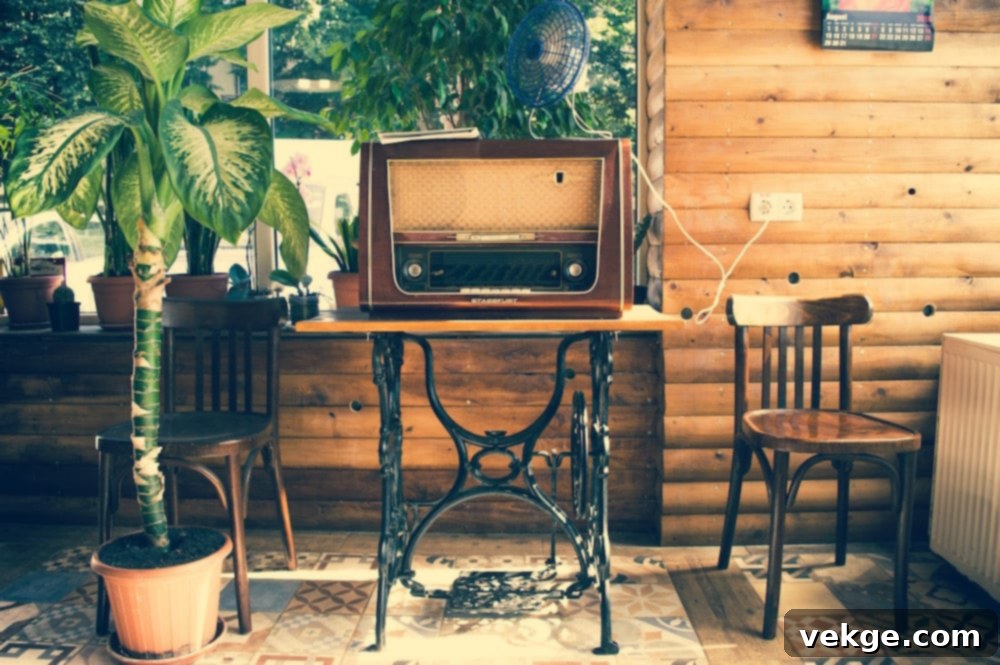
5. Bare Light Bulbs: Illuminating with Simplicity
The iconic Edison light bulb, with its visible tungsten filament, is far more than just a source of light; it’s a significant design element in industrial home decor. This simple yet stylish bulb embodies the raw, minimalist ethos of the style, turning a basic necessity into an aesthetic statement. Industrial design embraces the beauty of utility, and bare light bulbs, whether hanging as pendants or integrated into exposed fixtures, provide a warm, inviting glow that complements the overall rustic look. They eschew elaborate shades in favor of showcasing the bulb itself, contributing to an authentic, no-frills ambiance. Explore various shapes and sizes of these beautiful bulbs to give your home that quintessential, raw industrial charm and a touch of vintage elegance.

6. Cultivating a Neutral Color Palette: The Foundation of Calm
Industrial spaces typically feature a grounded and calming neutral color palette, drawing inspiration from the raw materials of factories and warehouses. This palette predominantly consists of sophisticated shades of browns, deep blacks, cool greys, and earthy tans. These colors not only mimic the natural tones of metal, concrete, wood, and brick but also provide a versatile backdrop that allows the unique textures and forms of industrial elements to stand out. While bright white isn’t always the primary choice in a purely industrial scheme, it can work exceptionally well in a more minimalist industrial setting, adding brightness and a clean contrast. By carefully applying these neutral hues to walls, furniture, and textiles, you can create a defined industrial look that simultaneously fosters a relaxed and inviting atmosphere, making your space feel both urban and tranquil.
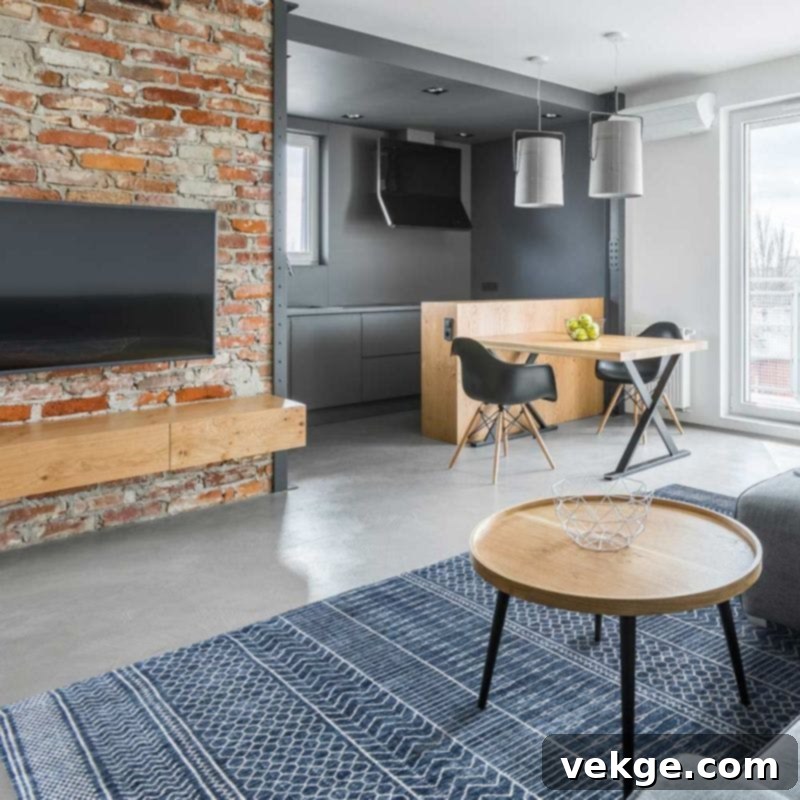
7. Opening Up the Space: Embracing Expansive Layouts
Large, open spaces are a fundamental characteristic and a highly desirable element within the industrial interior design paradigm. This design principle is directly inspired by the vast, unpartitioned layouts of factories, warehouses, and industrial complexes, which prioritized functionality and movement. Achieving expansive floors and high ceilings is crucial for capturing the true essence of this look, as they contribute to an airy and unconfined feeling. Even in homes with more conventional layouts, smart design choices can create the illusion of greater space. Minimalist furniture arrangements, strategic use of lighting, and avoiding clutter can help open up your rooms, allowing for better flow and an enhanced sense of freedom that resonates with the industrial aesthetic. The goal is to maximize visual lines and create an uninterrupted, flowing environment.
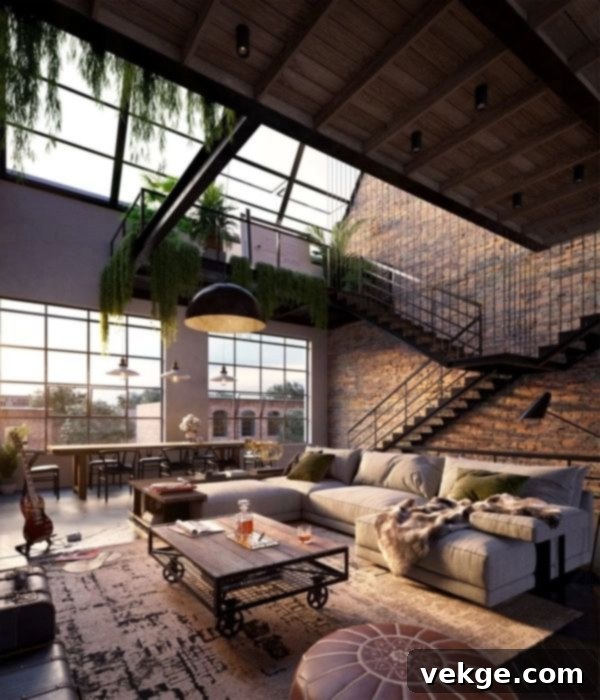
8. Concrete: The Unyielding Foundation of Industrial Style
Central to the industrial aesthetic is the celebration of a building’s architectural structure, and concrete stands out as a primary material in this regard. Its raw, unadorned presence perfectly captures the utilitarian spirit of industrial spaces. Incorporating concrete floors, whether polished or left with a more rugged finish, immediately sets a robust and minimalist tone. Beyond flooring, concrete countertops in kitchens and bathrooms, or even accent walls, contribute to a sleek, durable, and effortlessly cool look. Concrete’s strength, versatility, and neutral grey tones make it an ideal material for grounding an industrial design, embodying both functionality and a stark, modern beauty. It’s a material that speaks of permanence and raw honesty, truly capturing the authentic spirit of an industrial space.
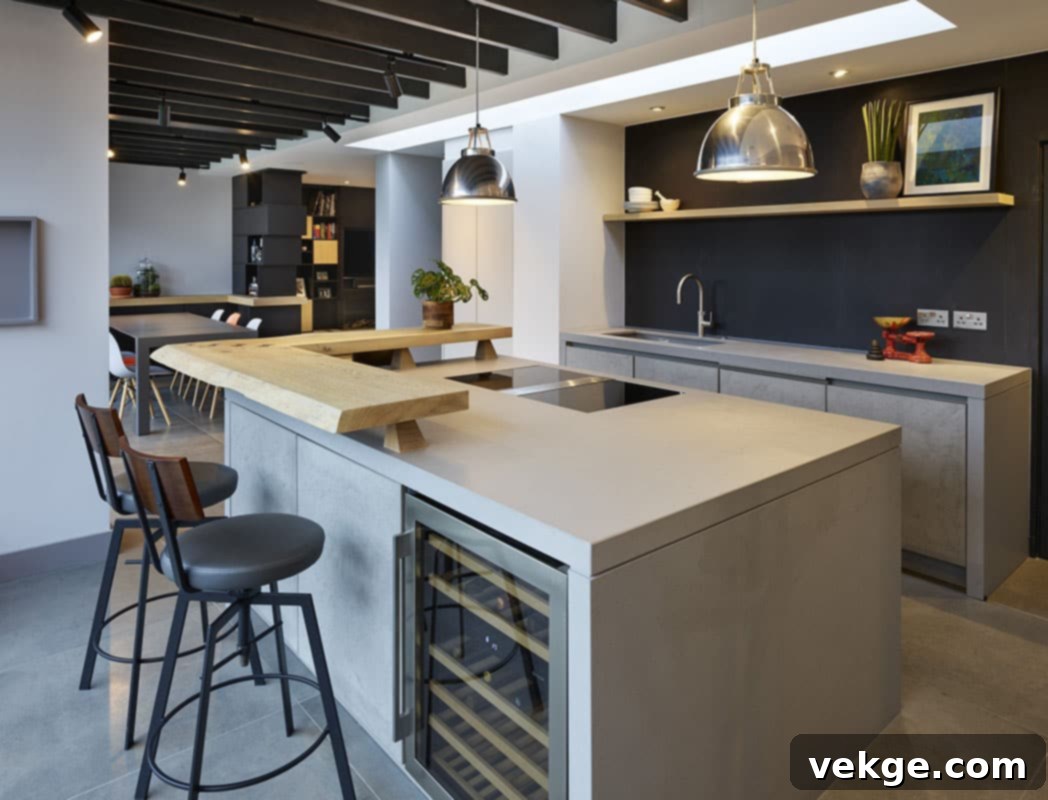
9. Large Windows: Maximizing Light and Openness
Large windows are not merely functional in industrial home decor; they are pivotal design statements. Especially those with a distinctive black grid frame pattern, they are among the finest elements to incorporate. These expansive windows play a crucial role in making a space feel larger and more open, while also adding a layer of sophisticated style. Beyond their aesthetic appeal, they are highly practical, allowing an abundance of natural daylight to flood the interior throughout the day. This not only creates a bright and airy atmosphere but also significantly reduces the need for artificial lighting, contributing to energy efficiency. Large windows also serve to blur the lines between indoors and outdoors, connecting your urban sanctuary with the world outside, a nod to the factory settings where expansive glazing was essential for worker productivity.

10. Metal Stools: Functional and Stylish Seating
Stools are an excellent way to enhance your industrial-themed space, offering both practicality and style while occupying minimal footprint. For cultivating a true industrial decor, opting for bar metal stools is a fantastic choice. Stools featuring robust metal legs, often in a raw finish or with dark, black undertones, instantly provide a chic and utilitarian aesthetic. They perfectly embody the industrial principle of combining form and function, often seen in workshop or factory settings. These stools are incredibly versatile, fitting seamlessly at kitchen islands, home bars, or as accent seating in living areas. Their clean lines and durable construction make them a long-lasting and stylish addition, offering comfort without compromising the urban edge. Consider these bar metal stools for a touch of practical elegance and a definitive industrial statement.

11. Pendant Lights and Large Domes: Illuminating with Purpose
Large domes and pendant lights are deeply rooted in the functional lighting requirements of factories and industrial complexes, where they were essential for providing ample illumination across vast spaces. In industrial home decor, these lighting fixtures are reimagined to offer both efficient lighting and significant aesthetic appeal. They often feature robust metal shades, exposed cords, or cage designs, bringing a strong utilitarian yet stylish presence to a room. Hanging dramatically over a dining table, kitchen island, or as a cluster in a living area, these lights become focal points, drawing the eye and reinforcing the industrial theme. Their design is a perfect blend of practicality and visual impact, ensuring every corner of your house is well-lit while enhancing the overall design narrative.
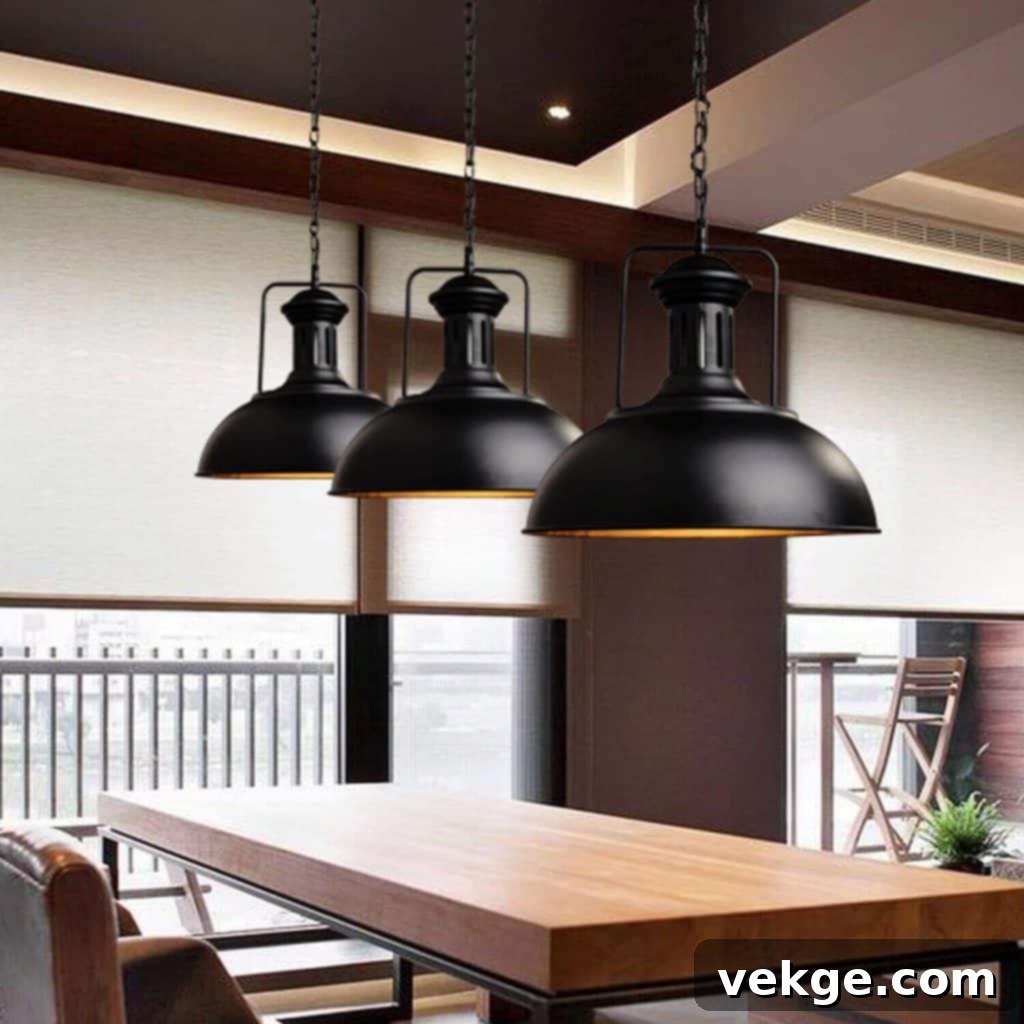
12. The Warmth of a Copper Touch: Adding Luster and Heritage
Copper, a classic industrial material, offers a unique opportunity to introduce a rich tinge of color and warmth into an otherwise neutral palette, while simultaneously adding a touch of modernity and timeless elegance to your house. Its distinctive reddish-brown hue and beautiful luster evolve with age, developing a desirable patina that speaks volumes about heritage and authenticity. You can effortlessly incorporate this copper touch through various elements: think sleek copper kitchenware such as pots and pans prominently displayed, a stunning copper backsplash, or even light fixtures and plumbing details. A kitchen adorned with gleaming copper accents instantly creates a lovely vintage industrial look, blending functional beauty with historical charm. Copper’s presence adds a sophisticated metallic sheen that contrasts beautifully with raw wood, concrete, and exposed brick.
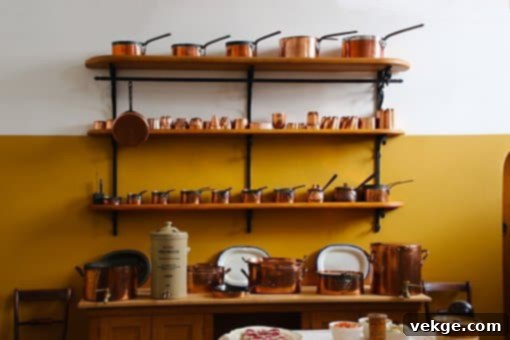
13. Distressed Leather: Comfort with a Rugged Edge
Distressed leather is an incredibly powerful and cool element for industrial decor, offering a perfect blend of ruggedness, comfort, and sophisticated aesthetics. Its aged appearance, characterized by natural wear, wrinkles, and variations in tone, tells a story and adds an authentic vintage appeal. Many industrial-style homes feature distressed leather sofas, armchairs, or even dining chairs, which introduce a beautiful textural contrast and a rich, inviting color to the space. This material not only provides exceptional durability but also develops more character over time, perfectly complementing the unfinished and raw elements typical of industrial interior design. A distressed leather piece instantly elevates the room, injecting warmth and a touch of luxury while maintaining the edgy, urban vibe that is central to the style.
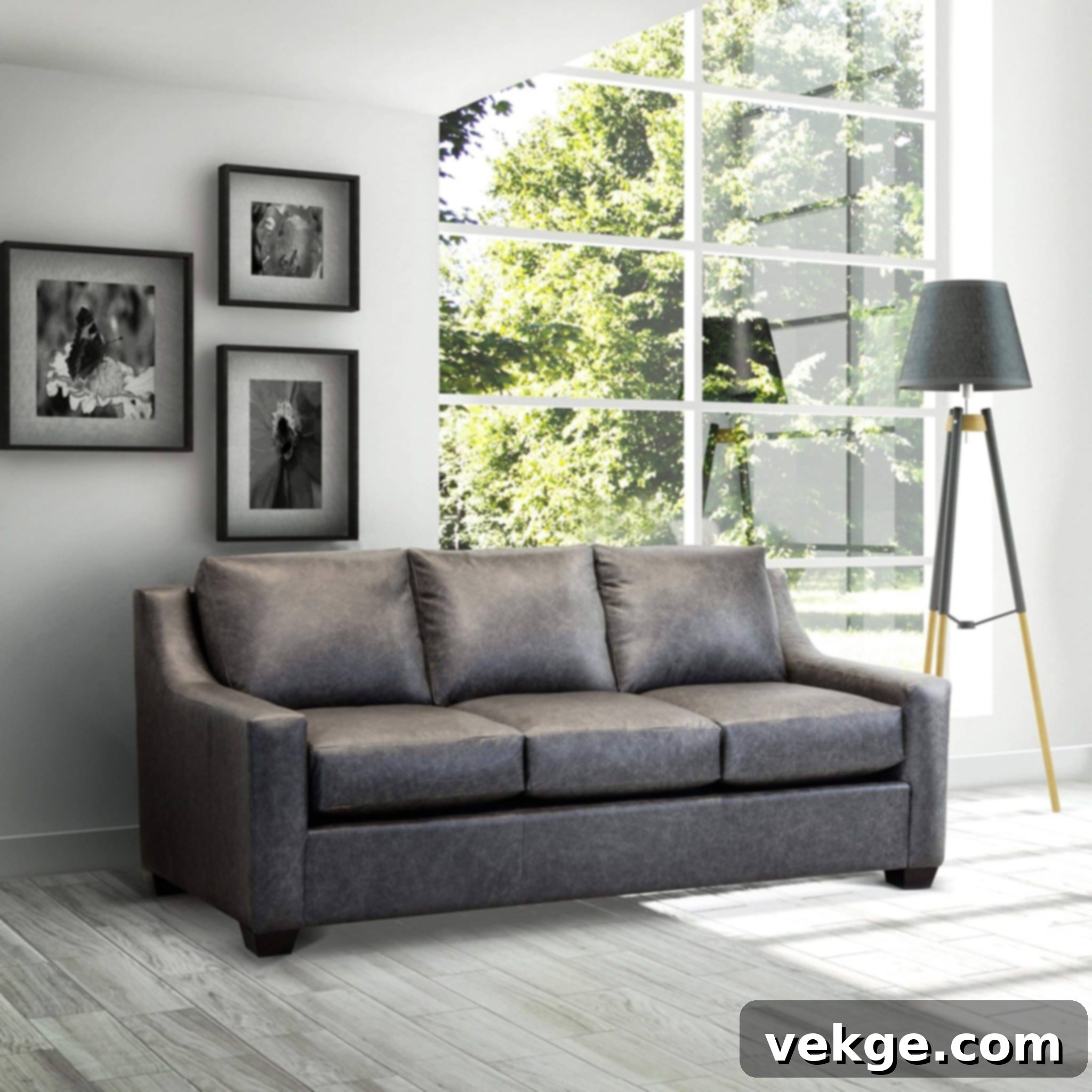
14. Strategic Storage Solutions: Keeping the Raw Organized
While industrial style is famously about embracing the unfinished and imperfect features of a space, it’s equally crucial to integrate smart and sufficient storage solutions. Clutter can quickly undermine the clean, expansive feel that industrial design aims for, turning a chic urban loft into a chaotic mess. Therefore, thoughtful planning for storage is essential to maintain the integrity of the design. Think creative and functional storage elements that complement the industrial aesthetic, such as open metal shelving units, repurposed vintage lockers, sturdy wooden crates, or built-in cabinets with minimalist hardware. These solutions not only provide necessary organization but also contribute to the overall aesthetic, allowing you to showcase items purposefully while tucking away the rest. The key is to ensure that storage is both practical and visually consistent with the raw, utilitarian theme.

15. Industrial Flooring: Setting the Groundwork
The flooring is a foundational element that profoundly impacts the overall style and feel of any space, making it essential to pay close attention to this aspect in industrial decor. Concrete floors are an exemplary choice, offering a raw, minimalist, and incredibly durable base that immediately establishes the industrial tone. Whether polished to a high sheen or left with a more matte, natural finish, concrete is an integral part of capturing the style’s utilitarian beauty. Beyond concrete, raw-looking wooden floorings, particularly reclaimed wood or wide-plank distressed hardwoods, are excellent options that introduce warmth and organic texture while maintaining a rugged aesthetic. Stone flooring, with its natural variations and robust feel, can also provide an authentic, earthy contrast. The right flooring sets the stage, seamlessly integrating with other industrial elements to create a cohesive and striking interior design.
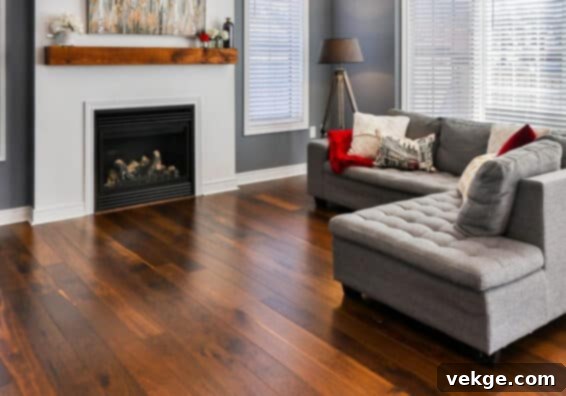
16. Integrating Nature: Softening the Edges with Greenery
While industrial style is renowned for its robust, resilient, and often stark themes, a beautiful and increasingly appreciated trend involves introducing elements of nature into these raw and unfinished spaces. Incorporating green indoor plants, for instance, provides a vital organic contrast to the hard lines of metal, concrete, and brick. Plants soften the industrial edge, infuse life and freshness into the environment, and contribute to a more positive and breathable ecosystem within your home. Whether it’s a large potted fig tree, hanging succulents, or a collection of small potted herbs on a metal shelf, greenery adds an essential touch of biophilic design. This thoughtful blend creates a harmonious balance, transforming a potentially austere industrial space into a vibrant, clean, and truly inviting sanctuary – the kind of place we all aspire to live in.
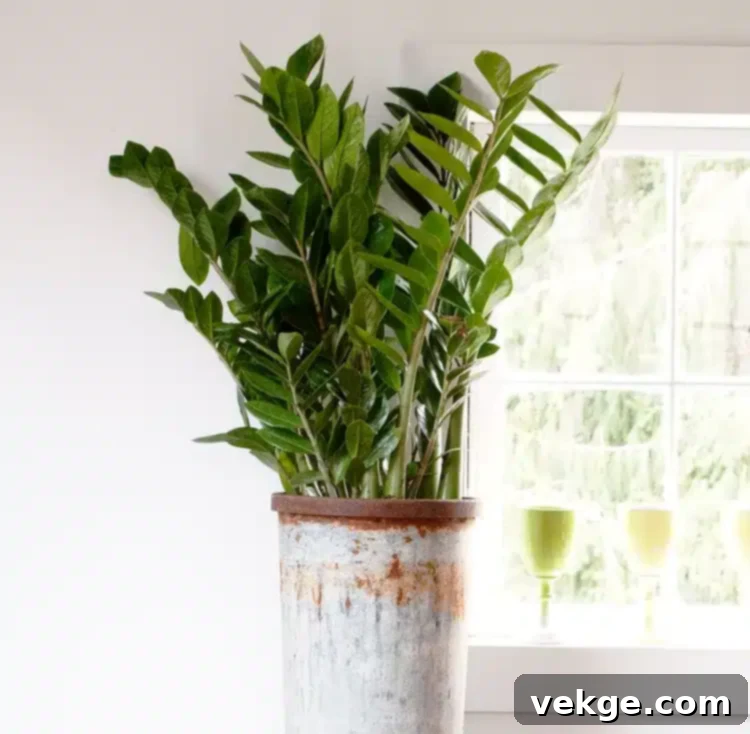
Conclusion: Embrace Your Industrial Transformation
Industrial interior design is a profoundly unique and captivating style that, when executed thoughtfully, can utterly transform a living space. However, its distinct aesthetic requires careful implementation to avoid pitfalls. This comprehensive article has provided you with an in-depth look at 16 essential elements that will guide you in giving your home a complete, authentic industrial makeover. By integrating these key components – from exposed structural elements and rugged materials to vintage accents and smart lighting – you can transition your space from ordinary to an extraordinary showcase of urban chic.
We sincerely hope this guide has not only answered your questions about the popularity and unique appeal of industrial design but also served as a powerful source of inspiration. Embracing this minimalist yet rustic style means celebrating authenticity, functionality, and a touch of raw beauty, creating interiors that are sure to win over any heart with their distinctive charm and inviting atmosphere. Start your industrial design journey today and craft a home that truly reflects your unique style.
